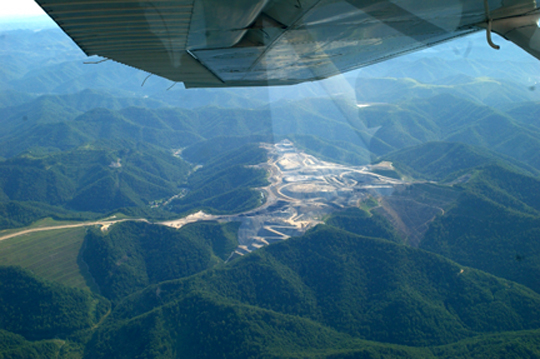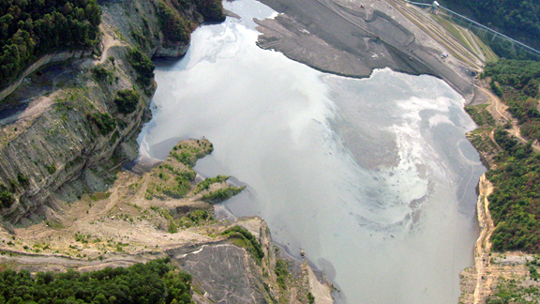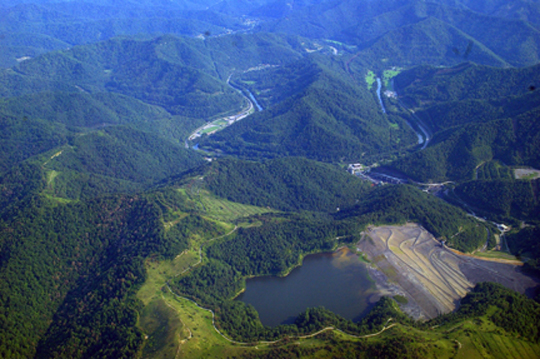((mtr_include))
This week, Gabriel Pacyniak and Katherine Chandler are traveling throughout southern West Virginia to report on mountaintop removal mining (MTR). They’ll be visiting coalfields with abandoned and "reclaimed" MTR mines, and talking with residents, activists, miners, mine company officials, local reporters, and politicians.
We’ll publish their reports throughout the week.
—–
Tom White’s directions to Yeager Airport instruct us to follow the signs outside of town, turn right at the first fork, and take the road straight up to the top of the hill. Like many of the instructions that we have received, he tells us, "And if you think you’ve gone too far, it’s probably just a little bit farther up." The airport is, in fact, on a flattened mountain overlooking the city of Charleston, a location that shows how difficult it is to find flat land in the area.
Tom’s business card reads "In deep? WHO YA GONNA CALL. Contract lawyer for hire … former newspaper reporter, author, commercial pilot." He’s also passionate about the environment, so he is a perfect fit for Southwings, a non-profit conservation organization that links volunteer pilots with journalists and researchers studying conservation issues in the south. It’s a pretty crucial service for anybody looking at mountain top removal mining (MTR). On the ground, you can drive up a hollow all the way over the mountain and never know that just beyond the trees the mountains have been mined away.

A mine site with valley fill in Mingo and Logan counties. (photo: Katherine Chandler)
"She’s a tough workhorse in the air, but she is very delicate on the ground," says Tom of his 30 year-old Cessna, giving us a brief speech on how to treat his plane. And then we are in the air, climbing out of Charleston. Southwestern West Virginia opens up below us as we head to about 5000′. The amount of undeveloped land is striking; all the way to the horizon it’s a patchwork of steep-sloped mountains covered with hardwood forests. Tom tells us that West Virginians like to think that their state would be as big as Texas if it were flattened out.
But MTR sites scar the landscape like craters on the moon. We fly south along the Big Coal River valley, passing towns like Sylvester, Marfork and Kayford, where we met Larry Gibson yesterday. From the sky, we see that devastation repeated over and over again. There are at least two or three large mines on the horizon at any time; in the course of our hour and a half flight, we pass more than 50 sites, some larger than a small city.

Active and reclaimed mine sites in Mingo and Logan counties. (photo: Katherine Chandler)
It is not only mountain tops that have been affected be MTR. Tom points out the other components of the strip mining operations that we can see from the air; valley fills, where waste-rock is dumped over the side of a mine into creek beds; coal slurry pounds and sediment ponds, where liquid waste, water and chemicals used to separate and wash coal sit in massive artificial ponds; and coal cleaning and processing plants, which can spew coal dust over local communities.

A wastewater retention pond serving MTR mines in Boone county. (photo: Katherine Chandler)
As we make our way southwest, through Boone, Logan and Mingo counties, we can also see "reclaimed mines." For the most part, it’s easy to identify the former mine sites from the air — most are still flat and pale green, covered with grass, unable to support the native plants on their dozed soil. Thirty years ago this summer, Congress passed the Surface Mining Reclamation, and Control Act (SMCRA) to regulate surface mining. It requires MTR mines to return a site to the "approximate original contour," but its obvious from the air that doesn’t happen in many cases.

Coal slurry pond. (photo: Katherine Chandler)
We do pass by some former mine sites that have been developed after the strip mining operations have finished, a selling point of MTR proponents. Tom points out the Logan airport, which was once an MTR mining site. Other former mines have been turned into a speedway, airport and a jail, though White remarks that he doesn’t see an intense demand for developable land in southwest Virginia. "We keep losing population, a little bit every year," he says.
Tomorrow, a Mingo County family living below an MTR site tells us about how Coal Country celebrates Earth Day.



